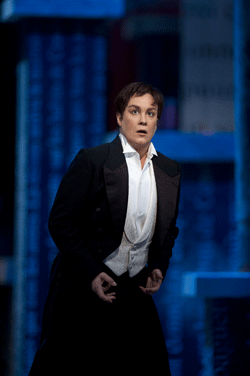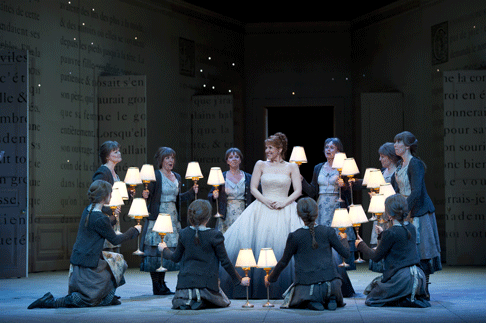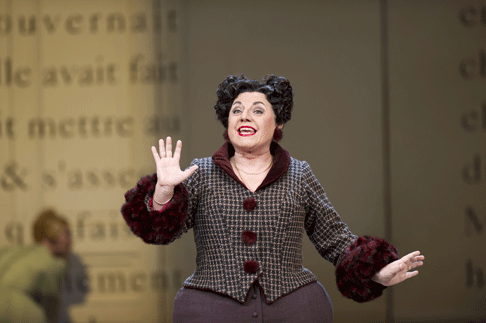12 Jul 2011
Cendrillon, Royal Opera
Words, stories, books — the gateway to a world of fantasy in which anything is possible.

Words, stories, books — the gateway to a world of fantasy in which anything is possible.
This is the starting point for Laurent Pelly’s vision of the Cinderella story — this, and the substantial faithfulness with which Massenet’s opera adheres to the original Perrault fairytale. The opening tableau is the opening pages of the Perrault, enlarged to wall-size; a small room soon grows into a bigger room, and a bigger room still. Soon, words are everywhere. As Lucette — the eponymous Cendrillon — falls sadly asleep in the middle of the first act, the stars come out — pin-pricks in the text on the wall, just where the dot of every ‘i’ should be. Next, ten or so Lucette-clones appear with lamps in their hands, as if making the stars dance, and thus the text begins to come literally to life.
 Alice Coote as Le Prince Charmant
Alice Coote as Le Prince Charmant
The clones turn out to be the pet spirits of Lucette’s Fairy Godmother, who get sent off to prepare Cendrillon’s gown and carriage and horses. Of course it is handy having ten singers and dancers running round the stage who look exactly like the heroine — an eminently practical way of ensuring that the real Cinders can be smuggled off unnoticed for her quick change.
The word-theme continues throughout, with Cendrillon’s carriage being made of the letters of the word “Carosse” (drawn by four dancers dressed as horses) and the giant golden gates of the palace being formed of the letters of the phrase “Les portes du palais”. Some would think this slavish, but I simply got a strong and comforting sense that Pelly has a real, affectionate love for this children’s tale.
The princesses at the ball were a grotesque array of cartoonish ladies in red, all with exaggerated shapes and figures (none more so than Cendrillon’s unpleasant stepmother and sisters, the former resplendent in what looked more like a piece of amply-upholstered furniture than a dress) and many looking like Grecian urns or elaborate topiary. If I hadn’t known that the production dates back to 2006 (in Santa Fe) I would have thought them a reference to the Queen of Hearts in the Royal Ballet’s recent Alice’s Adventures in Wonderland. Cendrillon is, after all, one of the few French 19th-century operas where a ballet scene fits nicely into the story without having to have an opportunity created for its existence, and it is telling that as I left the opera house at the end of the evening, I had strains of various divertissements from The Nutcracker floating through my mind along with snippets of Massenet.
If the visual inventiveness lapses in the early part of Act 3, all is restored in the curious ‘Fairy Oak’ scene (an invention of Massenet and his librettist) in which the stage is transformed into a rooftop scene (chimneys replacing the forest trees of the stage directions) which at first conjured up the chimney-sweep scene from Mary Poppins. But later a more apt comparison occurred to me; it’s the sort of scene generally seen from the garret window in La boheme. This is more relevant than you might think, as despite the supposedly fantastical context, it becomes one of the opera’s most genuinely human scenes, climaxing in a rapturous love duet in which the Prince’s voice joins Lucette’s in glorious unison before parting into harmony.
It was in this duet, and to a lesser extent their other scenes together, that the two stunning mezzo leads were showcased to best effect. The voices worked wonderfully well together — Joyce DiDonato’s tone sweet and soprano-like in the title role, and Alice Coote’s velvety, plush shades as an ardent Prince Charming. Individually of course they were just as good. Coote has plenty of experience in trouser roles, and not merely because of her voice type — her credibility as a hot-blooded youth is impeccable, evidently the result of meticulous observation. Meanwhile, DiDonato had a handful of high pianissimi which didn’t quite come off, despite the fact that the high-lying role generally seems to sit very comfortably in her voice, but she was a delightful heroine, making much of the understated, attractive music Massenet gives her.
 Joyce DiDonato as Cendrillon
Joyce DiDonato as Cendrillon
DiDonato was equally touching in the scenes with her father, Pandolfe, sung by the French bass-baritone Jean-Philippe Lafont. Lafont makes much of the character, but his voice is evidently far beyond its peak, grating and wobbly.
In less distinguished company, the great Polish contralto Ewa Podleś as Madame de la Haltière would have walked away with the entire show. Her lower register remains earth-shaking, but more to the point, she understands the critical importance of playing farce straight. Her final declamation of ‘Ma fille!’ — when she finally sees fit to acknowledge Lucette as a daughter — brought the house down.
Pelly generously makes this latter-day change of heart a result of an intervention by the Fairy, rather than a cynical acknowledgement ot Lucette’s sudden acquisition of status and glamour. And what an accomplished Fairy we had in the Cuban-American soprano Eglise Gutiérrez. She is confident and ravishing in spinning high lines, and her trill is so impressive that I will forgive her the occasional intonation lapse in staccato coloratura. Her poised and alluring stage presence put me in mind of Tytania from Britten’s Dream; she was given a bit of an edge with a modern, spiky hairdo, and I wouldn’t have been surprised to see a pair of customised Doc Marten boots under her lavish silver-grey ballgown.
 Ewa Podleś as Madame De La Haltière
Ewa Podleś as Madame De La Haltière
ROH Young Artists Madeleine Pierard and Kai Rüütel were well-matched as the two stepsisters, Noémie and Dorothée; in the first scene (in which, incidentally, they appeared to be dressed as pastel-coloured lampshades) their diction was indistinct, but this improved as the evening went on.
Bertrand de Billy’s conducting, a couple of lapses in ensemble aside, had energy and sensitivity. But the Fairy clearly thinks she can do a better; atop a giant pile of books, like a Valkyrie calling from a mountain-top, she hijacks the task of conducting the final few bars to make quite, quite sure of her happy ending.
Ruth Elleson © 2011